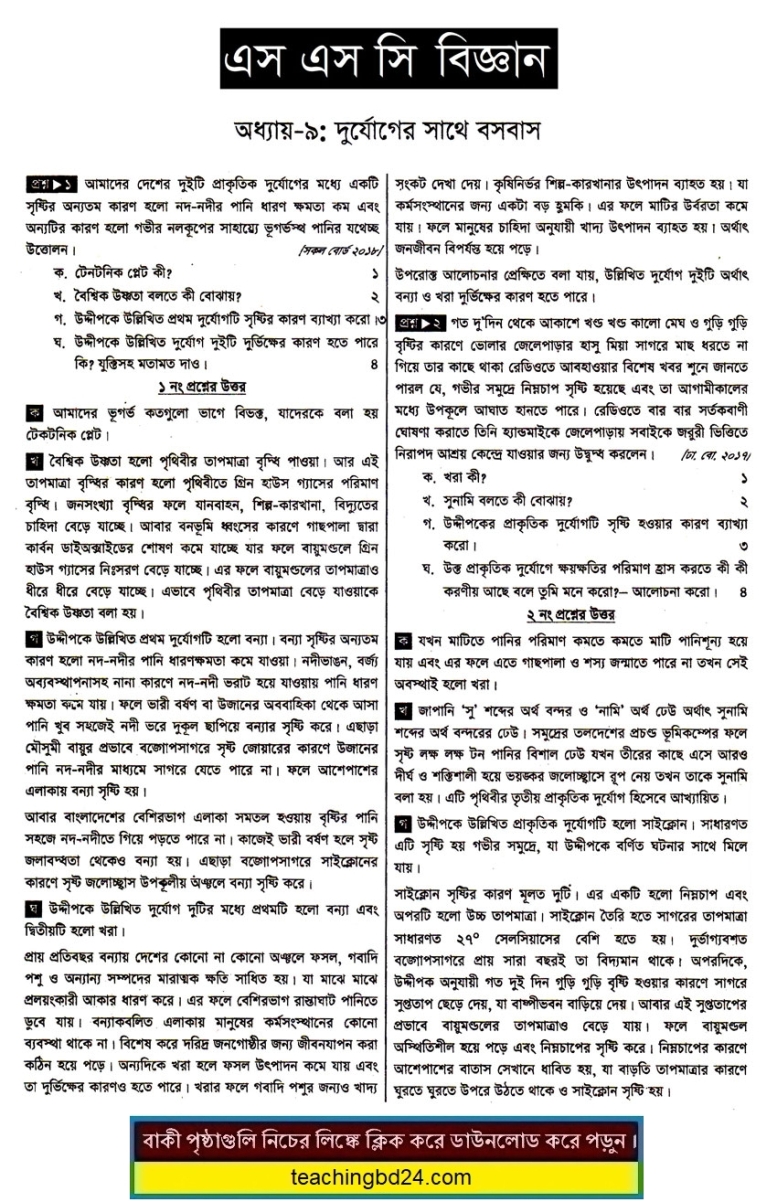Chapter 9. Living with Disaster
Chapter 9. Living with Disaster. Introduction: Natural disasters like floods, cyclones, drought and so forth are very common in Bangladesh. The irreparable loss of lives and properties created by these types of disasters is the main stumbling block for the development of our economy. These disasters have become terrible at present because of different types of human interference in nature.
Seasonal variation: Bangladesh is a land of six seasons and each season had its own characteristic. A remarkable change is going on regarding the season cycle because of climate change. Though Ashar and Shravan make the rainy season, heavy rainfall is occurring in the month of Ashwin and this is causing the untimely flood. On the other hand, winter is getting shorter day by day.
Chapter 9. Living with Disaster


It is also noticeable that summer has become hotter and sometimes at daytime the temperature reaches up to 45-48 °C in some parts of the country. Similarly, winter temperature, especially in the northern part of the country, becomes very low. Many people die because of this unusual and extreme weather condition.
A hazard is any natural process that poses a threat to human life or property. … The term disaster is used when the interaction between humans and a natural process results in property damage, injuries, or loss of life. A catastrophe is a massive disaster with significant deaths, injury, and economic loss.
Because of the scientific method, we understand why most natural disasters occur and where. For example, because of the theory of plate tectonics, we know understand why nearly 90 percent of all-natural disasters occur in the Pacific Ocean called the Ring of Fire. That same theory has helped to explain why some volcanoes are more explosive than others. We also understand that different tectonic plate boundaries produce different fault lines and thus different types of earthquakes.
Natural hazards also have seasons – especially those controlled by external forces. The United States has more tornadoes than the rest of the world combined and mostly occurs in the spring. Landslides are also most prone in the spring when snow begins to melt and over-saturate the ground. Wildfires are common in the middle of summer when the land is dry and thunderstorms tend to produce lightning without any precipitation. And hurricanes tend to peak in late August and into September when the ocean is warmest.
Since hazards are predictable in some manner, it becomes important to develop some kind of warning system. Predictions, such as weather predictions, state that it will occur at a specified time, date, and intensity. It is like saying a major snowstorm will reach Salt Lake City at 4:30 PM for the commute home. Now a forecast is slightly different. A forecast states a probability of something occurring; such as 40 percent of showers today. Forecasts are much broader than predictions.
One final note I’d like to discuss is the difference between a watch and a warning. A watch is issued when the conditions for a particular event are right. So if a thunderstorm is strong enough and rotating, it is possible that a tornado may form. Or if an earthquake with a magnitude of 7.5 strikes somewhere in the ocean, a tsunami watch may be issued because the earthquake was strong enough to create one. But a watch does not mean that it will occur. But is a tornado is spotted on the ground or an ocean sensor records an approaching tsunami, then a warning is sent out to the areas that could be impacted.
teachingbd24.com is such a website where you would get all kinds of necessary information regarding educational notes, suggestions and questions’ patterns of school, college, and madrasahs. Particularly you will get here special notes of physics that will be immensely useful to both students and teachers. The builder of the website is Mr. Md. Shah Jamal Who has been serving for 30 years as an Asst. Professor of BAF Shaheen College. He expects that this website will meet up all the needs of Bengali version learners /students. He has requested concerned both students and teachers to spread this website home and abroad.

